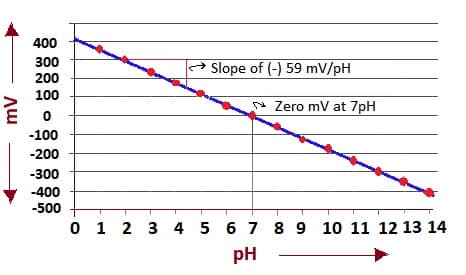Importance of pH Electrode Calibration
The pH measurement accuracy depends on how accurate the calibration of electrodes. The calibration of the pH electrode is very simple. However, the user is not aware of the reasons for the calibration of the pH sensor.
A standard pH combination pH electrode determines the pH value by measuring the potential generated in mV (millivolts). We compare this mV with the reference electrode constant potential. The reference electrode potential is independent of pH.
The pH value shows the acidity or alkalinity of the solution. The presence of a relative number of Hydrogen ions (H+) or Hydroxyl ions (OH-) ions determines the pH of a solution.
The reference electrode uses calomel saturated with potassium chloride. The calomel serves as a saline bridge that allows the passage of millivolts generated to the measurement circuit.

What is a combination electrode?
Nowadays, the pH measurement system is very excellent, it has a combination electrode. The combination electrode has the H + sensing electrode and reference electrode. In combination electrode, the reference electrode and H+ sensing electrode area separated.
The combination of both in one structure led to a combination electrode. However, the practice industrial continues to use reference and pH electrodes separately. Because it allows more reliable signals and maintenance procedures that, in certain cases, are more controllable and lower cost.
Reference Electrode
The important function of the reference electrode is to provide a constant potential. The indicating electrode measures mV(millivolts).The difference between millivolts of a reference voltage and indicating electrode is the pH value of the solution. The accuracy of the measurement depends on the measurement accuracy of the reference electrode. Therefore, the following requirement must be met.
- The ionic strength of the electrolyte must be much higher than that of the sample.
- The solution in it must be an equitransferent solution.
- Reference electrode solution must not react with the sample.
- The solution in the reference electrode must not contaminate the sample.
- Solution in the reference should never contain the ion.
Calibration Preparation of standard solutions
Preparation of the solutions with different concentrations by diluting the standard “stock” solution with deionized water. The standards must cover the expected concentrations in the samples.
Practical considerations
- Both the samples and the calibration solutions must have the same temperature.
- All measurements must be carried out under the same stirring conditions.
- All measurements must be carried out under the same lighting conditions, preferably in glass beakers opaque.
- Care should be taken in proper maintenance of the electrode.
- Damages such as scratches, etc., and deposits on the surface of the sensitive membrane obstruct the response of the electrode.
Concentrated samples (> 0.1 M) must be diluted before carrying out the measurements
The below graph is for mV reading (ordinate) against the pH of the concentration of the standards used. We can determine the slope of the electrode from the line obtained.

The theoretical slope of the selective measuring electrode, in the linear response interval, is 59 mV/Unit pH unit of concentration at 25 ° C. In practice, the slope obtained in the calibration indicates the good or bad operation of the electrode.
Calibration procedure of pH electrode
Generally, the calibration is required successively with different concentrations, preferably in increasing order of concentrations. Two-point calibration is the most precise method. In two-point calibration, the meter adjusts at two different pH readings.
When measuring acidic solutions, we use a buffer solution of pH = 4. When measuring an alkaline, we use a buffer solution of pH = 7. To do this, both electrodes are immersed in the standard solution and then start the stirrer.
- Initially place the electrode with distilled water.
- Rinse the electrode in pH = 7 buffer solution.
- Wait for the measured value to stabilize and note the final value (pH = 7).
- Before immersing the electrodes in the next solution, they must be washed with abundant deionized water and carefully dried with absorbent paper.
- The selective membrane should not be rubbed.
- It is advisable to dry it by contact.
- Rinse the electrode in the second buffer solution, it may be pH = 4 or 10.
- Wait for the meter reading to get stabilized, and it will show pH = 4 or 10.
- Takeout the electrode and rinse in distilled water.
- Now, the electrode is placed in pH = 7, the meter should read the same. Otherwise, repeat the above calibration steps using both buffers.
Note: The number of standards used and the calibration frequency depend on the working conditions and the precision required by the user.
Read Next :
No word about how the temperature compensation should work which is one of the most common errors in pH measurements !
Temperature of buffer solutions is important while measuring pH. This can be done in two ways. One is automatic temperature compensation. Another one is by checking the solution temperature and doing adjustment manually, for example room temperature 26deg C or whatever.